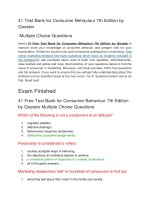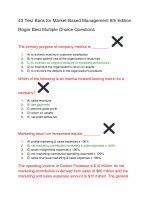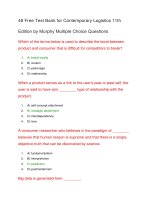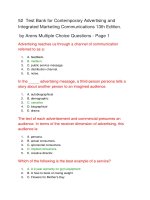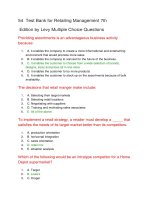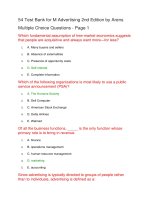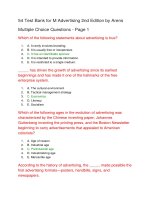54 test bank with answers for m advertising 2nd edition by aren1
Bạn đang xem bản rút gọn của tài liệu. Xem và tải ngay bản đầy đủ của tài liệu tại đây (82.45 KB, 14 trang )
54 Test Bank for M Advertising 2nd Edition by Arens
Multiple Choice Questions - Page 1
Which of the following statements about advertising is true?
1.
2.
3.
4.
5.
A. It rarely involves branding.
B. It is usually free or inexpensive.
C. It has an identifiable sponsor.
D. It is intended to provide information.
E. It is restricted to a single medium.
_____ has driven the growth of advertising since its earliest
beginnings and has made it one of the hallmarks of the free
enterprise system.
1.
2.
3.
4.
5.
A. The cultural environment
B. Tactical management strategy
C. Economics
D. Literacy
E. Socialism
Which of the following ages in the evolution of advertising was
characterized by the Chinese inventing paper, Johannes
Guttenberg inventing the printing press, and the Boston Newsletter
beginning to carry advertisements that appealed to American
colonists?
1.
2.
3.
4.
5.
A. Age of reason
B. Industrial age
C. Preindustrial age
D. Industrializing age
E. Mercantile age
According to the history of advertising, the _____ made possible the
first advertising formats—posters, handbills, signs, and
newspapers.
1.
2.
3.
4.
5.
A. quill pen
B. printing press
C. silk screen
D. ability to mold lead
E. ability to copy and draw
_____ is the process of creating, communicating, and delivering
value to customers and for managing customer relationships in
ways that benefit the organization and its stakeholders.
1.
2.
3.
4.
5.
A. Management
B. Advertising
C. Communications
D. Logistics
E. Marketing
Since advertising is typically directed to groups of people rather
than to individuals, advertising is defined as a:
1.
2.
3.
4.
5.
A. channel.
B. subtle medium.
C. sponsor-driven strategy.
D. market segmentation strategy.
E. kind of nonpersonal communication.
The period in the evolution of advertising that extended from the
beginning of recorded history to roughly the start of the nineteenth
century was called the:
1.
2.
3.
4.
5.
A. sales era.
B. positioning age.
C. industrial age.
D. industrializing age.
E. preindustrial age.
Which of the following statements is true about word-of-mouth
advertising?
1.
2.
3.
4.
5.
A. It is not a communication medium.
B. It is not an advertising medium.
C. It is a paid form of advertising.
D. It is an openly-sponsored form of advertising.
E. It has a structured form.
Which fundamental assumption of free-market economics suggests
that people are acquisitive and always want more—for less?
1.
2.
3.
4.
5.
A. Many buyers and sellers
B. Absence of externalities
C. Presence of opportunity costs
D. Self-interest
E. Complete information
_____ is the structured and composed nonpersonal communication
of information, usually paid for and usually persuasive in nature,
about products or ideas by identified sponsors through various
media.
1.
A. Marketing
2.
3.
4.
5.
B. Sales promotion
C. Advertising
D. Feedback
E. Message channeling
As a marketing tool, advertising is most likely used to:
1.
2.
3.
4.
5.
A. create unfair advantages among competitors.
B. encourage buyers to compare prices.
C. control viral commercialization.
D. increase product use.
E. create feedback.
Which of the following organizations is most likely to use a public
service announcement (PSA)?
1.
2.
3.
4.
5.
A. The Humane Society
B. Dell Computer
C. American Stock Exchange
D. Delta Airlines
E. Walmart
During the _____ age, manufacturers were principally concerned
with production, and the primary burden of marketing fell on the
wholesalers.
1.
2.
3.
4.
5.
A. preindustrial
B. postindustrial
C. industrializing
D. industrial
E. isolation
Which of the following is the best example of a service?
1.
2.
3.
4.
5.
A. A seminar on how to quit smoking
B. A gift basket of fruit
C. Vitamins to improve one's health
D. Gift wrapping paper sold at a school fund-raiser
E. A donation of clothes to the Salvation Army
Which of the following is an example of a good?
1.
2.
3.
4.
5.
A. A medical examination
B. An Internet provider
C. A copier
D. A haircut
E. A car warranty
When Mollie buys a box of disposable diapers and June purchases
a copy of the Wall Street Journal, both are acting as:
1.
2.
3.
4.
5.
A. buying centers.
B. consumers.
C. product innovators.
D. strategic points of service.
E. product adopters.
During the preindustrial age, most advertisements took the form of
signs with symbols such as a beer tankard indicating a tavern
because:
1.
2.
3.
4.
5.
A. most people were illiterate and could not read.
B. most firms could not afford more sophisticated advertisements.
C. local laws prohibited advertising in newspapers.
D. most churches would not approve other forms of advertising.
E. signs and symbols were considered lucky.
The 4 Ps of the marketing mix are:
1.
2.
3.
4.
5.
A. product, price, place, and promotion.
B. product, people, process, and promotion.
C. people, price, place, and product.
D. product, process, people, and physical evidence.
E. place, people, product, and process.
Which of the following would most likely involve a Public Service
Announcement (PSA)?
1.
2.
3.
4.
5.
A. Dell recalling laptops to correct manufacturing defects
B. Verizon promoting a new data plan with unlimited texting
C. Walmart advertising year-end discounts and clearance items
D. American Red Cross promoting blood donation opportunities
E. A local Chevrolet dealer providing the address of its new showroom
What did the first ad in English advertise?
1.
2.
3.
4.
5.
A. A plow
B. A farm
C. A prayer book
D. A religious service
E. A pub
Advertising reaches us through various channels of communication
referred to as:
1.
2.
3.
4.
5.
A. feedback mechanisms.
B. media.
C. encoding tools.
D. distribution methods.
E. information processes.
In the context of free-market economics, the use of taxation and/or
regulation to compensate for or eliminate the social cost when the
sale or consumption of products may benefit or harm other people
who are not involved in the transaction and didn't pay for the
product, falls under the assumption of:
1.
2.
3.
4.
5.
A. many buyers and sellers.
B. absence of externalities.
C. presence of opportunity costs.
D. self-interest.
E. complete information.
Benjamin Franklin:
1.
2.
3.
4.
5.
A. was the first American known to use illustrations in ads.
B. was the first to print color ads.
C. was the first American to use copy in ads.
D. printed ads with no clutter.
E. minimized white space in ads.
Of all the business functions, _____ is the only function whose
primary role is to bring in revenue.
1.
2.
3.
4.
5.
A. finance
B. operations management
C. human resource management
D. marketing
E. accounting
54 Free Test Bank for M Advertising 2nd Edition by
Arens Multiple Choice Questions - Page 2
The term _____ best explains why most automobile manufacturers
produce similar products yet consumers have preferences for
specific brands.
1.
2.
3.
4.
5.
A. market segmentation
B. market formatting
C. product differentiation
D. strategic marketing
E. product segmentation
A decade after World War I ended, a significant event occurred that
caused consumer sales resistance, corporate budget cutting, and
advertising expenditures to plummet. This event was:
1.
2.
A. the imposition of a personal income tax by the federal government.
B. the defeat of Germany and its default on loans granted by the Allies.
3.
4.
C. the stock market crash and the beginning of the Great Depression.
D. the creation of the World Bank, which made loans available to state and
federal banks.
5. E. strong challenges to the consumer credit system as established by the
federal government.
The Cold War ended when the Berlin Wall came down and Western
companies and financiers began to invest heavily in what were
once called the Warsaw Pact countries. Big multinational
companies and their advertising agencies went on a binge, buying
other big companies and adding a new term to the financial lexicon.
This term was:
1.
2.
3.
4.
5.
A. partnering.
B. capitalism.
C. oligopoly.
D. mega merger.
E. service economy.
_____ is a type of marketing used to slow down the demand for
certain products, such as energy-consuming goods.
1.
2.
3.
4.
5.
A. Co-marketing
B. Demarketing
C. Environmental advertising
D. Eco-marketing
E. Systems marketing
Due to mobile phones, PCs, the Internet, e-mail, and cable TV,
advertising is evolving into a(n):
1.
2.
3.
4.
5.
A. two-way medium.
B. broadcast medium.
C. analog medium.
D. narrowcasting medium.
E. reiterative advertising medium.
Which term best refers to items such as detergent, nail polish, soda,
and pretzels?
1.
2.
3.
4.
5.
A. Customized packaged goods
B. Consumer packaged goods
C. In-house products
D. Branded products
E. Serviceable goods
Which of the following occurred near the end of the nineteenth
century and accelerated the usage of print ads by manufacturers?
1.
2.
3.
4.
5.
A. World War I finally ended.
B. Global advertising agencies formed.
C. Newspaper advertisements decreased in cost.
D. The United States reached a 90 percent literacy rate.
E. English was established as the official language of the United States.
By publicizing the material, social, and cultural opportunities of a
free enterprise society, advertising has encouraged:
1.
2.
3.
4.
5.
A. increased productivity by both management and labor.
B. interactive consumption on a global level.
C. relationship marketing.
D. a service economy.
E. nonprofit organizations.
What role did the firm N. W. Ayer & Son play in the history of U.S.
advertising?
1.
2.
3.
A. It was the first printer to use illustrations in its ads.
B. It was the first manufacturer to use national advertising.
C. It was the first ad agency to charge a commission based on the "net cost of
space."
4. D. Its advertising claims were the first examined by the Food & Drug
Administration.
5. E. It published the first colonial newspaper with advertisements for local
businesses.
With respect to the evolution of advertising in the United States, the
_____ age started around the turn of the twentieth century and
lasted well into the 1970s.
1.
2.
3.
4.
5.
A. service marketing
B. relationship marketing
C. industrial
D. production
E. mercantile
Two related economic factors characterized the marketing world of
the late 1980s and early 1990s in the United States. One of those
factors was:
1.
2.
A. an aging upper management that led to a lack of innovation.
B. the growing burden of financial debt, which forced governments to return to
high tax policies directed toward business.
3. C. the implementation of affirmative action policies.
4. D. the aging of traditional products and a corresponding growth of
competition.
5. E. the development of strong consumer trust.
The _____ age, which began around 1980, has been a period of
cataclysmic change due to increased environmental awareness.
1.
2.
3.
4.
5.
A. service-market
B. post-production
C. market relationship
D. postindustrial
E. customization
During a drought in the southeastern United States, marketing
campaigns were implemented to encourage consumers to use less
water by increasing rates and issuing fines to those who used more
than their fair share. A marketing effort such as this would best be
classified as:
1.
2.
3.
4.
5.
A. co-marketing.
B. eco-marketing.
C. demarketing.
D. relationship marketing.
E. cause marketing.
In 2005, Comcast created AZN, a television network for Asian
Americans. What type of strategy did Comcast use when it found
this unique group of consumers whose specific needs were not
being addressed by a cable station?
1.
2.
3.
4.
5.
A. Positioning
B. Demarketing
C. Product differentiation
D. Market aggregation
E. Market segmentation
Which of the following is the largest advertising medium in terms of
advertising revenues?
1.
2.
3.
4.
5.
A. Internet
B. Newspapers
C. Magazines
D. Television
E. Radio
Many urban hotels are creating women-only floors for female
travelers. Enhanced security and toiletries more likely to appeal to
women such as bubble bath and curling irons are made available.
To specifically target women who are traveling on their own, these
hotels have implemented a _____ strategy.
1.
A. product segmentation
2.
3.
4.
5.
B. targeted diversification
C. demarketing
D. market segmentation
E. market aggregation
The industrializing age of the nineteenth century saw the shift of
orientation from:
1.
2.
3.
4.
5.
A. production to consumption.
B. sales to consumption.
C. sales to customer relationship management.
D. production to sales.
E. consumption to production.
To differentiate its candy from that produced by other candy
manufacturers, the manufacturer of Green & Black brand
confections advertises that it is the only company to make its
chocolate organically. This commitment to market only organic
chocolate is an example of a(n):
1.
2.
3.
4.
5.
A. perceptual value.
B. unique selling proposition.
C. economic differential.
D. economic advantage.
E. differential value.
A(n) _____ is an effective way to separate a particular brand from
its competitors by associating that brand with a particular set of
customer needs that rank high on the consumer's priority list.
1.
2.
3.
4.
5.
A. logistical strategy
B. universal sales promotion
C. positioning strategy
D. market aggregation strategy
E. promotional mix
_____ is a process by which marketers search for unique groups of
people whose needs can be addressed through more specialized
products.
1.
2.
3.
4.
5.
A. Product segmentation
B. Targeted diversification
C. Demarketing
D. Market segmentation
E. Market aggregation
Which of the following statements best describes how Volney B.
Palmer influenced advertising?
1.
2.
A. In 1729, he became the first to use "white space" and illustration in ads.
B. In 1841, he set up the first professional advertising agency in the United
States.
3. C. In 1869, his advertising agency becomes the first to prepare ads for
manufacturers.
4. D. In 1888, he founded the Printer's Ink magazine.
5. E. In 1912, he became the first advertising agent to reach $2 million in sales.
As the U.S. economy slowed in the 1980s, which cost-effective
method did companies use to trim their advertising budgets?
1.
2.
3.
4.
5.
A. Mass market advertising
B. Viral marketing
C. Sales promotions
D. Internet advertising
E. Word-of-mouth advertising
There is some of the most beautiful scenery in the world at the
Banff National Park in Canada. Too many tourists have led to
potential ecological disasters in the park. In response, park officials
are trying to decrease the number of visitors to the park. They could
most likely use _____ to accomplish this objective.
1.
2.
3.
4.
5.
A. positioning
B. eco-marketing
C. co-marketing
D. demarketing
E. relationship marketing
What type of strategy is being used by a Web site like
www.CNNMoney.com when it describes itself as "a one-stop
destination covering everything a small-business owner needs to
know" in order to associate itself with benefits that are important to
small business owners?
1.
2.
3.
4.
5.
A. Market penetration
B. Target differentiation
C. Positioning
D. Market segmentation
E. Sales promotion
Which term refers to the distinctive benefits that make a product
different than any other?
1.
2.
3.
4.
A. Perceptual value
B. Unique selling proposition
C. Economic differential
D. Economic advantage
5.
E. Differential value
Why did magazines become the ideal medium for advertising in the
1840s?
1.
2.
3.
4.
5.
A. Magazines offered the best quality reproduction.
B. Magazines were less expensive than newspapers.
C. Magazines were read more often than newspapers.
D. Advertisers were tired of using newspapers to carry their messages.
E. No taxes were imposed on magazine advertising unlike newspaper
advertising.
Which of the following terms explains the availability of cable
networks devoted to food, home repair, golf, history, or animals?
1.
2.
3.
4.
5.
A. Mass marketing
B. Two-way media
C. Relationship marketing
D. Narrowcasting
E. Broadcasting
Why is 1896 considered an extremely important year for direct mail
advertising and mail-order selling?
1.
2.
3.
4.
5.
A. Advertising agencies were allowed to charge commissions for their
services.
B. The U.S. Post Office was created.
C. The Office of Consumer Affairs guaranteed that consumers could return
products that did not meet their needs.
D. The Federal Communications Commission took control of all mail order
and direct mail advertising.
E. The Federal Government inaugurated rural free mail delivery.
Who is considered the father of advertising art?
1.
2.
3.
4.
5.
A. Francis Ayer
B. Benjamin Franklin
C. Volney B. Palmer
D. Johannes Gutenberg
E. N. W. Ayer
The term integrated marketing communications means:
1.
2.
3.
4.
5.
A. developing a long-term marketing strategy.
B. communicating marketing information to a target audience.
C. linking the sales and communication departments in a firm.
D. training a sales force to use proper marketing skills.
E. coordinating a firm's messages from a variety of sources.


